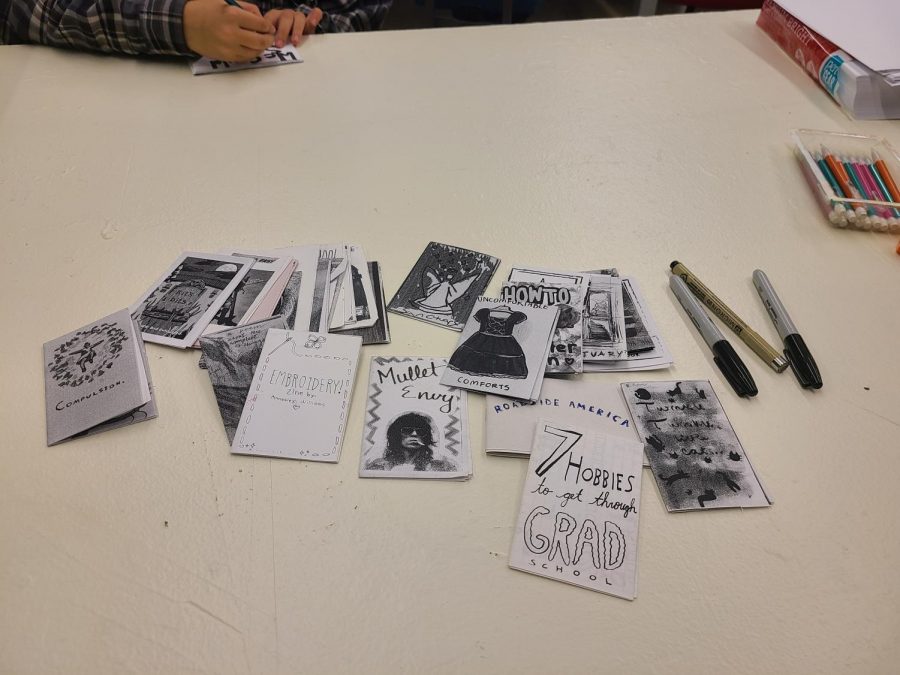SAS hosts zine workshops
Club showcases simple way to share ideas
Examples of Zines on a table during the workshop. Zines are short magazines that focus on a particular subject and are defined by their flexibility.
The Student Art Society hosted zine workshops on Sunday, Oct. 3 and Sunday, Oct. 10 in Doane Hall of Art to give students the opportunity of learning about an art medium and showcasing their work in an upcoming exhibition. The date of the exhibition has not been decided yet.
Guest speakers Doug Eberhardt and Lauren Lowery of Jet Black Press led the workshop.
Lowery revealed that Jet Black Press is the name under which she and her husband create small publications. They explained the nature of zines as lo-fi, self-published periodicals that are made in copies of 50 or less.
“(Lowery) had started making zines before I did and then I jumped on the bandwagon and started making them,” Eberhardt said. “When I saw what she was making, I really liked it and I thought about what I could do with zines. I thought it could be an interesting outlet for me as an artist.”
According to Eberhardt, the workshop was brought to students so they could learn about the history of zines and how they fit in the art world as pieces that do not require a lot of resources or face creative conflicts with publishers.
“Zines are a way for people to have fun and explore creative expression,” Lowery said. “They are a way to possibly build communities around a form of expression or an idea. They are also easy, cheap and quick to make. Zines give people the room to express themselves without having to go through a publisher who tends to have overhead control.”
Eberhardt brought attention to the ways zines have been used to distribute voices that have not been widely heard. He explained that zines give more people the opportunity to make art that could range from being highly interpretative to completely direct.
“In the historic start of zines, they were often political and that gave artists the opportunity to say what they wanted to say through art,” Eberhardt said. “When you make a piece of artwork, there is usually a lot of poetry to the piece in that there is a subtle message that the viewer needs to interpret. What I like about zines is that they are the opposite, where they just tell you exactly what you want to know in a lot of ways.”
Ryan Martinez, ’22, explained how zines fit into his busy lifestyle as a student and the appeal of an art medium that can be easily distributed.
“I learned that zines were quick mediums for art and I don’t usually have a ton of time so I thought it would be cool to keep adding to a zine in my spare time,” Martinez said. “In the end I can just have a finished product that I can mass produce in a fun way.”
While the zine workshop attracted a lot of people with artistic backgrounds, students from other fields were also interested in the art form. Martinez, for example, a student in the STEM field so he looks for opportunities where he can have a creative outlet.
“I’m a biology major and I guess art allows me to focus on getting better at something that involves expression, which I don’t normally have a ton of outlets for,” Martinez said. “Zines are cool because I can have an idea I want to express or I can have a bunch of random ideas and each page can be something different.”
Silas Morrow, ’21, shared how participating in the workshop benefited him mentally and creatively.
“It’s been fun to work on, it’s just like something else to do to take my mind off all the other things that I have to do,” Morrow said. “It’s nice that you can just put whatever in it and it still has a structure. All you have to do is figure out what to put on the pages.”
Zines are considered to be creatively free since an artist can decide in what format they want to convey a message.
“I really like the narrative element where you can tell a story with ongoing images or text,” Eberhardt said.
President of SAS Erin Magnus, ’23, explained the aspect of zines that facilitated her creativity.
“I find myself creating more art on margins and smaller places than on larger canvases,” Magnus said. “I guess I just have an affinity for small things and zines can be really small.”
Magnus shared her inspiration for one of her completed zines.
“I had a song stuck in my head about worms so I just made a zine about worms,” Magnus said. “Zines really can be anything.”

Evelyn Zavala is a senior from San Francisco. She is majoring in Business and minoring in Journalism in the Public Interest. This is her fourth year on...









